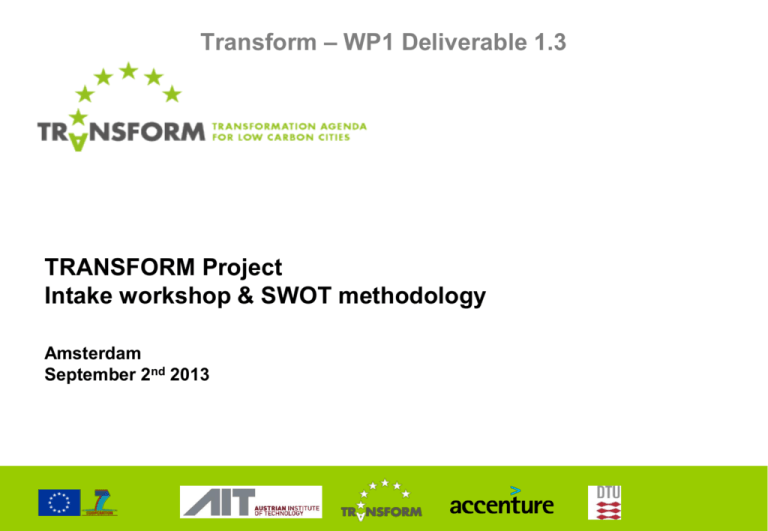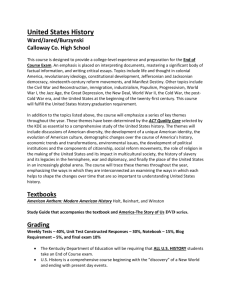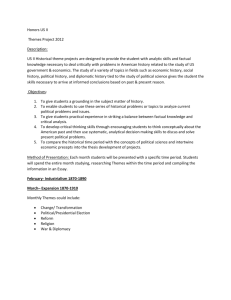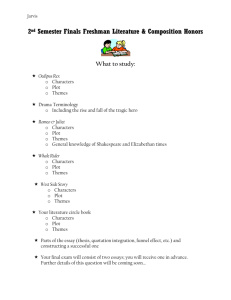
Transform – WP1 Deliverable 1.3
TRANSFORM Project
Intake workshop & SWOT methodology
Amsterdam
September 2nd 2013
TRANSFORM Intake workshop & SWOT methodology
The intake workshop methodology was developed to support cities in deciding what to focus on in the TRANSFORM
programme. The workshop is also facilitates a natural flow between the conclusion of WP1 and the start of the
support for cities from WP2. The analysis conducted by WP1 including the baseline analysis and the scoring of cities
on their performance on elements of the Smart Energy City definition is the starting point. The SWOT methodology
will build on this and provide a more detailed analysis of the specific barriers and opportunities for the city. Lastly, the
decision will be made on what will be asked from the TRANSFORM programme, mainly focusing on qualitative
decision support tools, such as financial models, legal frameworks and stakeholder engagement.
How To Use This Document
This document provides information on the intake workshop and the Transformation Agenda. This document is a
proposed set up of the intake workshop. The workshop design and the tools (SWOT methodology and impact versus
ability to implement matrix) are yet to be finalised. The main addition will be to process feedback from the city and
adjust the tools and methodologies after feedback from facilitators.
In the coming months the generic proposal will be tested in the city workshops, which are planned as follows:
City
Proposed Split
Date
Vienna
Accenture & Arup
17-18 Sept
Amsterdam
Accenture
8-9 Oct
Copenhagen
Arup
Early Oct
Hamburg
Arup
Early Oct
Genoa
Accenture
24-25 Oct
Lyon
Accenture
1-2 Nov
Copyright © 2011 Accenture. All rights reserved.
Deadline for reviewed
methodology is set for
December
2
Introduction to the Transformation Agenda
Objectives of the Transformation Agenda
Workflow of the Intake workshop
(SWOT) Methodologies
3
Project Transform
August 2013
Definition of a Smart Energy City
The smart energy city definition combines the EU carbon reduction targets within the environmental, social and
economic goals of the city
/
Smart Energy City definition
The Smart Energy City, as a core to the concept of the Smart City, provides its users with a liveable, affordable, climate-friendly
and engaging environment that supports the needs and interests of its users and is based on a sustainable economy.
The Smart Energy City is highly energy and resource efficient, and is increasingly powered by renewable energy sources; it
relies on integrated and resilient resource systems, as well as insight-driven and innovative approaches to strategic planning.
The application of information, communication and technology are commonly a means to meet, these objectives.
Visual representation of the Smart Energy City definition
Smart projects
Integrated and resilient resource
system
Insight-driven and innovative
approaches to strategic planning
Information
Communication
Technology
Energy city objectives
Sustainable city objectives
Supports the needs and interests of
its users: Liveable
Relies
on…
Smart Energy City:
energy and resource efficient
Increasingly powered by
renewable energy sources
Means
to meet
Provides
users…
Affordable
Climate-friendly
Engaging environment
Sustainable Economy
4
Project Transform
August 2013
Transformation to a Smart Energy City
The Transformation Agenda will set out how the city progresses from it’s current state- demonstrated in the Baseline
Analysis- to become a Smart Energy City. The KPIs measure this progress.
/
Progression to a Smart Energy City
Strategy / operational
development
Baseline analysis
Based on the key elements of the SEC
definition; KPIs will be used to assess
the cities progress towards becoming a
Smart Energy City
The Transformation agenda as an
addition to the city’s existing Energy
Masterplan or equivalent document
Impact analysis
The Smart Energy City (SEC) definition
is the goal for the city but impact will be
assessed on EU 2020 Energy KPIs
Impact analysis
Baseline
Analysis
Transformation
Agenda
KPIs
City Masterplan +
Add ons from
Transformation
Agenda
Existing City
Masterplan
SEC
KPIs
Intake workshop
5
Project Transform
August 2013
Introduction to the Transformation Agenda
The main outcome of the workshop will a prioritization on 3-5 themes that will be worked on in the rest of the
TRANSFORM programme within a governance structure decided on by the stakeholders
City objectives of the intake workshop
/
The Transformation Agenda will not re-write
the city’s entire Energy Master Plan but will
help on certain areas of the city strategy
The outcomes of the intake workshop should help the city with:
1)
What to focus on within TRANSFORM:
Produce 3 integrated themes with commitment to work on these
themes within TRANSFORM by stakeholders
For the three integrated themes understand the key strengths and
weaknesses related to the enabling factors
Smart City / climate
action plan/
2)
Transformation
Agenda
How to ensure coordinated action by focusing on governance,
enablers and ability to implement:
Plan a governance structure around the 3 integrated themes
Involve stakeholders in the process to experience how the
framework strategy can be implemented
6
Project Transform
August 2013
Introduction to the Transformation Agenda
Objectives of the Transformation Agenda
Workflow of the Intake workshop
(SWOT) Methodologies
7
Project Transform
August 2013
7
TRANSFORM objectives for intake workshop
The objective of the city should align closely with the objectives of the TRANSFORM work packages where the focus
lies on testing and developing key methodologies such as the SWOT and down-selection methodology
TRANSFORM objectives of the intake workshop
The intake workshop is a key process-step in the development of the Transformation Agenda that will provide input for the
Transformation Agenda and help the process of developing a generic handbook for the EU
Generic city Transformation Agenda process:
WP 1:
•
Review of baseline scenario
•
Review and write-up SWOT methodology
Per city focus on key
intervention themes
In scope
Out of
scope
Coordinated action
around themes
Overview of interventions
and opportunities
•
•
EU generic objectives
The Intake workshop is the first step in the development
of a TA
The output of the intake workshop will be used to drive
coordinated action with stakeholders
WP 2:
•
Identify key priorities for the TA
•
Test down-selection process for the TA and
interdependency with enabling factors
•
Test entire process of intake workshop
WP 3:
•
Support decision-making process through data and
modelling
•
Test down-selection methodology
WP 5:
•
Develop Transformation Agenda Handbook for
dissemination in EU cities
8
Project Transform
August 2013
City objectives for intake workshop
The city of <<>> wants to use the intake workshop to decide on key priorities in the framework strategy and how to
act on these key priorities within a new governance structure
Current situation in City
City input for key questions
<<Input based on city situation>>
<<Input based on city situation>>
Illustrative
Energy
Masterplan
Key Themes
Enablers
Stakeholders
9
Project Transform
August 2013
Introduction to the Transformation Agenda
Objectives of the Transformation Agenda
Workflow of the Intake workshop
(SWOT) Methodologies
10
Project Transform
August 2013
Intake Workshop
This note introduces the Intake Workshop. Each city will have a two day workshop which will engage a range of key
stakeholders, allowing the Transform cities to focus and define the aspirations for their Transform Agenda.
½ day
6-8 weeks
1. Kick off call
2 days
3. Intake
Workshop
2. City Preparation
80+
Key
Themes
10
Key
Themes
3-5
Key
Themes
1. Kick off call
To prepare for the workshops a call will take place 2 months in advance between WP1 and the city coordinator.
The city will be provided with a long list of possible key themes typically assumed to be 80+ options at this stage.
Prior to the workshop, and in collaboration with WP1, the city will select 10 of these key themes they would like to focus upon.
2. City Preparation
Prior to the workshop, and in collaboration with WP1, the city will select 10 of these key themes they would like to focus upon.
The city will select the stakeholders for collaboration on the themes to invite to the intake workshop.
3. Intake Workshop
The workshop will build on:
- Existing work carried out by WP1: the Smart Energy City definition, the KPIs and the City Baseline Analysis.
- The city’s list of 10 selected key themes.
Question for City coordinators:
Two day intake workshop
A city-wide SWOT analysis will be undertaken to set the context
-
Review of the baseline data for the city and the 10 selected themes,
Down-selection from 10 key themes to highlight 3 - 5
Intake Workshop deliverables:
- SWOT analyses for the city and for their selected three key themes.
- Feeding into WP2: (Concept) Qualitative model and identification of cross-cutting and enabling themes for WP2
-
Should the first day be internal to
the city, and the second day
include external stakeholders?
Should the two days be
consecutive?
11
Project Transform
August 2013
Kick-off call
The first step will be a phone call between each city and WP1. The intake workshop will identify the specific needs of
each city; the call will assist all parties in with their preparation for the intake workshop.
When:
6 – 8 weeks prior to the scheduled Intake workshop for that city
Who:
Parties on the call will be the city coordinator, the Smart Urban Lab coordinator, WP1 representatives (Arup / Accenture and WP1 Package Leader), and
local manager for WP2.
Agenda:
1. Objectives for the city- What does the city want to get out of the intake workshop?
A discussion to agree the objectives for the city, exploring the following questions: What does the city want to achieve from the intake workshop? What are the key
drivers for the city? What is the local context for the workshop? It is crucial that the workshop is planned in such a way that it is relevant to each specific city and
aligns with the local environment.
2. Key themes - What does the city want to focus on?
The intake workshop will refine the priorities for each city, by selecting a group of key themes to focus on.
During the kick-off call WP1 will present a sample list of 80+ themes for the city to consider, the city will then be guided by WP1 on how to refine this list.
I.
Localise the list- The city will be encouraged to review the sample list and freely tailor it. We will explore how the sample list aligns with the city’s existing local
policies, strategies and existing initiatives as well as their Climate Change Action Plan, sustainability plans and their Smart Urban Lab. The aim of this will be
to create a baseline, benchmark list of themes for action within each city.
II. Down-selection criteria- Over the following weeks , the city will be asked to refine their list of key themes. A clear set of downsizing criteria have been
produced to help the city achieve this. On the kick-off call, WP1 will provide the rationale behind the down-selection criteria and explain how the city can use
them.
3. Stakeholders- Who does the city want to involve?
In preparation for the intake workshop, the city will be asked to invite local stakeholder who they would like to engage in the process. During the kick-off call, WP1 will
provide some guidance on which stakeholders could be invited, and also discuss a process for inviting them.
4. Outputs- What does the City need?
Finally, the city and WP1 will review what outputs they hope to get from the workshop. Does this align with the City’s requirements? Does this align with the
requirements of the other Transform work packages?
12
Project Transform
August 2013
City Preparation part 1
In preparation for the Intake workshop, the city will have two main objectives, firstly to select their 10 top key themes
to focus on in the workshop and produce and invite a delegate list of stakeholders to attend the workshop.
Key Themes
A list of 80+ key themes for consideration will be issued to the city
prior to the intake workshop.
This list is not intended to be exhaustive and should be
supplemented with additional themes as the city requires.
Criteria for selection of key themes
Prior to, and during the workshop, the city will refine their focus for
their Transformation Agenda by down selecting their list of key
themes based on the following criteria.
The chosen key themes will be refined from 10 down to a final 3-5.
The final select of key themes will be those which:
- Facilitate a high level of stakeholder engagement;
- Align with the Smart Energy City definition and achievement of the
KPIs;
- Display through the SWOT analysis maximum impact and
achievability;
- Represent a diverse sample of industries/disciplines/subject areas;
- Are applicable in the Smart Urban Lab;
- Contain replicable elements for other cities;
Based on this criteria, the selected three to five key themes will
deliver the necessary balanced coverage of industry systems for the
formulation of the transformation agenda.
Question for City coordinators:
Selecting the key themes
- Should we request that themes are selected which cover a range of
categories?
- Should cities be free to select or not select certain areas?
Potential stakeholders for engagement
Existing Buildings
Housing authority
Building regulation
authority and/or
Planning authority.
Social housing
organization(s).
Waste Management
Waste operators /
management
companies
Waste treatment
companies
Advanced
Municipal waste
Treatment
operator / Contract
Technology
Management
Providers
Public Land Use
City Planners
Transport Planning
Local NGOs
Authority
Water
Water utility
companies
Waste water
Technology
treatment providers Providers
Energy Supply
Energy generators
Network operators
Electricity / gas /
other
Energy suppliers
Transport
Freight transport
companies
Dept. of Transport
Public transport
operators.
Private transport
manufacturers
Building retrofit
trade body
Major Land Owners
13
Project Transform
August 2013
City preparation part 2
The Key Themes selected by the cities for the Intake Workshop should represent each of the areas below to ensure
that the work undertaken during work package three can be representative of the city as an integrated system.
Existing Buildings
Buildings account for 45% of emissions,
and far more in cities in volatile climates
which require large amounts of heating and
cooling. Mayoral powers in the building sector
are usually strong.
List of themes
Water
Producing, treating and pumping water
requires a high amount of energy, so
actions to reduce water use contribute
significantly towards emissions reduction.
Cities must also find sustainable ways to
manage stormwater and wastewater
List of themes
Waste Management
Globally, waste accounts for 3% of
greenhouse gas emissions. Cities are
introducing ways to reduce the quantity,
through recycling and composting, and of
turning waste material in to energy.
List of themes
Energy Supply
65% of energy is generated from fossil
fuels. Cities are providing innovative
solutions to move towards low carbon and
renewable energy systems
List of themes
Public Land Use
Planning powers are critical for mayors to adapt
their cities to the impacts of climate change. For
example, increasing tree cover and protecting
green space improves quality of life and
absorbs carbon emissions, but also helps
reduce urban heat island effects and provides
flood protection.
List of themes
Transport
Cities emit over 300 million Tonnes of CO2 per
year from the transport sector. Cities usually
exercise strong powers in the transport sector,
in particular through the ownership or
operational control of key transport assets and
the ability to set and or enforce regulations.
List of themes
14
Project Transform
August 2013
Key elements of the Smart Energy City
The key elements of the SEC definition are incorporated into the structure in which to analyse the impact and
ability to implement the different themes
Key elements of the overall SEC definition
6 Active and engaged users
5 Renewable energy
4 Energy efficiency
1 Resource system integration
2 Access to energy services
3 Resilience
7 Sustainable economy
8 Smart governance
15
Project Transform
August 2013
(S) Spatial
opportunities
Ability to implement (PESTLEGS)
(L) Legislation
(E)
Environmental
(G)
Governance)
Measure
& values
(P) Political
involvement
(E) Financial
feasability
Market
Development
(S)
Stakeholder
enagement
(T)
Technological
enablers (ICT)
Impact: main KPI’s
%EE
Category
Renewable energy
Active and engaged users
Sustainable economy
Smart governance
% RES
Themes / Enabling Themes
5
6
7
8
City
sustainability
(economy,
society,
environment)
Resource system integration
Access to energy services
Resilience
Energy efficiency
CO2
1
2
3
4
City preparation part 3
The city and WP 1 will work closely together to prepare the inputs from the workshop based on work already
done in the baseline scenario and the KPI document
Flow of work for preparation
City
1. City provides list of
themes across all six
categories that they
wish to explore
Expected outputs and inputs
WP1
2. WP 1 provides
feedback on impact
of measures & ability
to implement based
on baseline
questionnaire and
KPI document
3. City finalizes set of
measures and
analysis of impact
Inputs:
Inputs:
KPI document
(level 1 – 4)
Baseline
scenario: data on
Energy KPIs
KPI document
(level 1 – 4)
Baseline scenario:
Influence on
assets
16
Project Transform
August 2013
Workshop workflow
The workshop flow is divided into seven sections which is centred around the analysis of the potential impacts versus
the enabling environment of the energy-related themes
Work Flow
Description
Objective
Presentation Facilitator WP1
o Introduce TRANSFORM project & individual intro‘s
o Present Baseline report / KPIs and SEC definition
Set expectations & explain
TRANSFORM goals
Presentation City Coordinator
o The generic framework for the TA, Focus Areas
o Presenting the list of Tier II themes considered
Understanding how
TRANSFORM can help to
achieve goals of the city
Plenary exercise: Plotting the themes
o Plotting themes :cost effectiveness versus ability to implement
o Group discussion to select main themes to SWOT
Initial analysis of what
themes face the largest
challenges
Group exercise (per Energy theme)
o
Discuss SWOT per theme with post-it notes
Consensus on the
strengths, weaknesses,
opportunity and threats
5. Discussion
Synthesis and plenary discussion
o Designated group leader presents SWOT
o Discussion around linkages and combined opportunities
Overall consensus on main
barriers and identify
linkages between themes
6. Enabling
environment
Group exercise (per Cross-cutting theme)
o Formulation of hypothesis to increase ability to implement
o Discuss governance issues regarding implementation
Identify clear mandate for
qualitative decision support:
e.g. finance, governance etc
Presentation WP2
o Wrap-up from TRANSFORM team.
o What to expect in the next year and a half of the programme
Clear expectation setting for
stakeholders and
TRANSFORM for next steps
1. Introduction
2. Themes and
objectives
3. Plotting the themes
4. SWOT
7. Wrap-up
17
Project Transform
August 2013
Introduction to the Transformation Agenda
Objectives of the Transformation Agenda
Workflow of the Intake workshop
(SWOT) Methodologies
18
Project Transform
August 2013
18
SWOT methodology
The SWOT analysis will be carried out on day 1 of the intake workshop.
SWOT Methodology
Intake workshop- SWOT analysis
1) Tier 1 selection: Key themes
3) SWOT part 1: Internal factors
Internal
•
•
Strengths and
weaknesses
•
Each ‘strategic theme’ will be analysed in turn.
The questions will follow a PESTLE framework to ensure
all considerations are covered.
The first set of questions will cover internal factors;
Strengths and weaknesses within the city’s control
4) SWOT part 2: External considerations
•
The second set of questions will cover external factors;
opportunities and threats beyond the city’s control
External
Opportunities
and threats
Political
Economic
Social
Technological
Legal
Environmental
Political
Economic
Social
Technological
Legal
Environmental
Stages 3) and 4) are repeated for each strategic theme
5) Synthesis: 2x2 matrices
•
A 2x2 SWOT matrix will be produced for each ‘strategic
theme’
Strengths
Weaknesses
Opportunities
Threats
19
Project Transform
August 2013
Etc.
Cycling/pedest
rian provision
SWOT
Mobility
Etc.
Financial
incentives
•
Each key theme will foster 3-5 more detailed ‘strategic
themes’.
These will be selected such that each can be considered in
isolation during the workshop (i.e. ‘Building energy
efficiency’ is suitably specific, whereas ‘CO2 reduction’ is
too general)
Etc.
•
Energy
infrastructure
2) Tier 2 selection: Strategic themes
SWOT
Buildings
Public
transport
SWOT
Energy
Energy
efficiency
In Vienna’s case- three high level themes have been
selected through the framework strategy
Heat and
power supply
•
Impact versus ability to implement
At the end of the workshop each city will commit to 3 – 5 themes with a hypothesis of what actions need to be
undertaken to improve the impact of the measure
For each chosen measure the stakeholders will sign off on a
scope of the interventions.
The scope of the themes will be set around expected impact,
interventions and interdependencies with enabling factors
Example: Waste to energy
Impact
Expected or desired impact (goal for
interventions) on KPIs (Energy and
sustainability)
Waste to energy (target)
Ideas for needed interventions to overcome
barriers to implementations…
a
a
Waste to energy
…. including interdependencies, synergies and
enabling factors
Illustrative
Ability to implement
20
Project Transform
August 2013
Appendix:
Background on SEC definition
Copyright © 2011 Accenture. All rights reserved.
21
Background from WP1
The smart energy city definition combines the EU carbon reduction targets within the environmental, social and
economic goals of the city.
Vision for the Smart City:
A liveable, resilient city, which is inclusive, climate friendly, data insight driven and fosters innovation and a sustainable economy.
Definition of a Smart Energy City (SEC):
The Smart Energy City, as a core to the concept of the Smart City, provides its users with a liveable, affordable, climate-friendly and engaging environment that
supports the needs and interests of its users and is based on a sustainable economy. The Smart Energy City is highly energy and resource efficient, and is
increasingly powered by renewable energy sources; it relies on integrated and resilient resource systems, as well as insight-driven and innovative approaches to
strategic planning. The application of information, communication and technology are commonly a means to meet these objectives.
Visual representation of the Smart Energy City definition:
Smart projects
Integrated and resilient resource system
Insight-driven and innovative approaches
to strategic planning
Energy city objectives
Supports the needs and interests of its
users: Liveable
Relies on…
Smart Energy City:
energy and resource efficient
Increasingly powered by
renewable energy sources
Information Communication Technology
Sustainable city objectives
Means to meet
Provides
users…
Affordable, climate-friendly, engaging
environment
Sustainable Economy
22
Project Transform
August 2013










